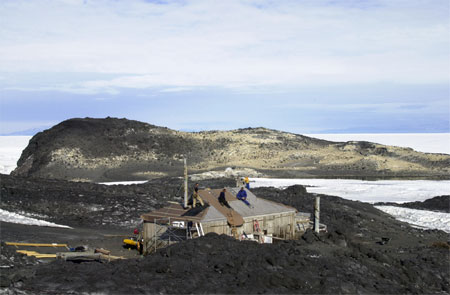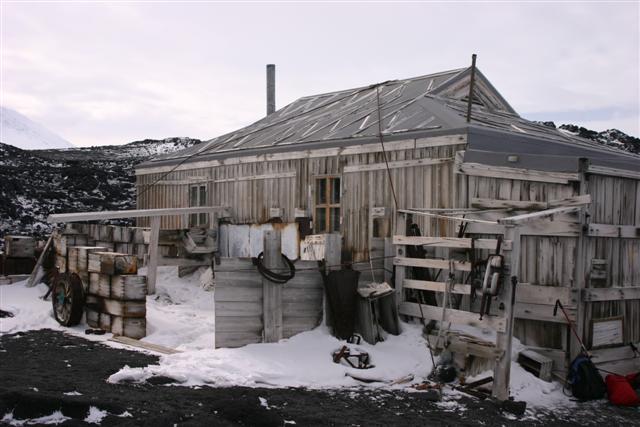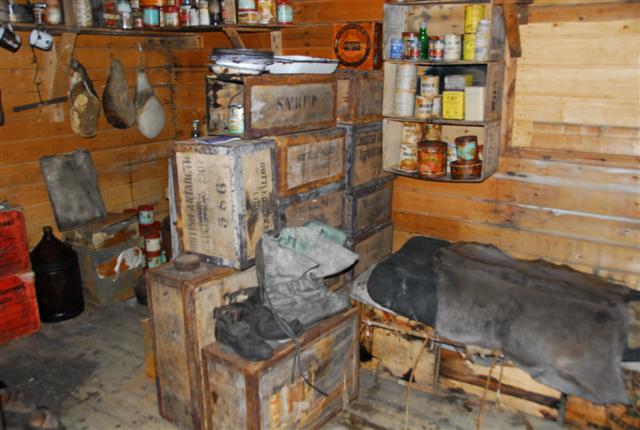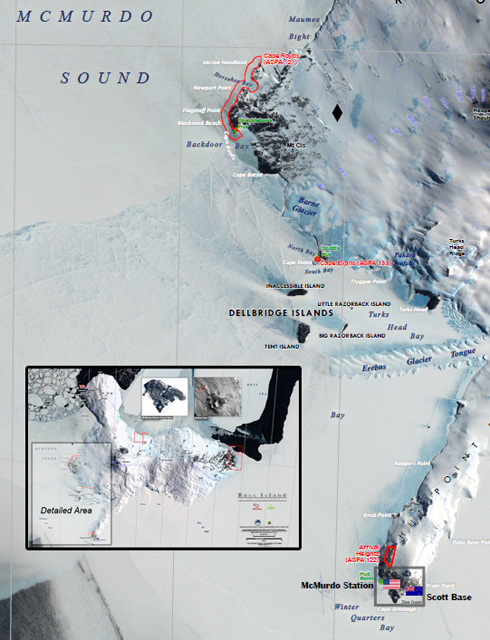|
History on iceCape Royds hut restoration project plans to recover Shackleton whiskeyPosted December 11, 2009
CAPE ROYDS, Antarctica — This spit of black volcanic rock that juts out along the coast of Antarctica is an inhospitable place. Temperatures drop below minus 50 degrees Fahrenheit and high winds cause blinding snowstorms. The only neighbors are a colony of penguins that squawk incessantly and leave a pungent scent in their wake. More on Antarctic conservation
But if you happen upon the small wooden hut that sits at Cape Royds and wriggle yourself underneath, you’ll find a surprise stashed in the foot and a half of space beneath the floorboards. Tucked in the shadows and frozen to the ground are two cases of Scotch whiskey left behind 100 years ago by Sir Ernest Shackleton after a failed attempt at the South Pole. Conservators discovered the wooden cases in January 2006. They were unable to dislodge the crates, but are going in with special tools in January during the Antarctic summer to try to retrieve them. An international treaty dictates that the crates, and any intact bottles that are inside, remain in Antarctica unless they need to be taken off the continent for conservation reasons. The whiskey’s condition after a century of freezing and thawing is unknown. Polar explorers of that era relied on their alcohol of choice to help them and their crews through the long Antarctic nights and insomnia-inducing days. And Shackleton knew a thing or two about being well prepared for an adventure. On a later trip to the continent, he kept all 28 members of his crew alive during 15 harrowing months after their ship was marooned in and then slowly devoured by ice. So it’s no surprise that he brought 25 crates of Scotch with him when he set off on an expedition to the South Pole in 1907. The earlier trip didn’t go well, either. Shackleton turned around 97 miles short of his destination, telling his wife, “I thought you’d rather have a live donkey than a dead lion.” When the ship arrived in 1909 to pick the men up, they left their supplies behind in their hut, including reindeer sleeping bags, tins of boiled mutton and bottled gooseberries. And, as we now know, they also abandoned two cases of Charles Mackinlay & Co. whiskey. Al Fastier is a program manager in New Zealand with Antarctic Heritage Trust “It was a very exciting time of actually finding artifacts that possibly hadn’t been seen since the historic explorers left,” he said. The group also found felt boots and jugs of linseed oil. The other 5,000 or so artifacts left behind are inside the hut or on the ground nearby and had been catalogued and viewed by the occasional tourist and on the Internet. In January, the conservationists will use a special drill that chips into the rock so they can pull the crates out and let them melt free in the omnipresent Antarctic summer sun. So what will century-old, Antarctic-iced Scotch taste like? Richard Paterson, master blender at Whyte & Mackay, the Glasgow whiskey company that now owns the Mackinlay label, is eager to learn of the whiskey’s fate. He’s equally hopeful that he gets to taste some of it. He has a 1907 letter from Shackleton acknowledging receipt of the cases, along with a photograph of the bottles’ label. The company may have donated the cases, which Paterson said cost 28 shillings each, as polar explorers came looking for sponsors for their trips, which were usually run on tight budgets. “Shackleton has been one of my heroes for many years,” he said. “It’s nice to think that perhaps we helped him when his other spirits were down, that our spirits kicked him up a wee bit.” Paterson said he’d expect that when bottled, the whiskey was heavy and peaty, which was the style in that era. He’d like to sample it by sticking a needle through the cork and extracting some of the liquid with a syringe. If the bottles stayed airtight — a big if since the corks may have shifted as they were expanding and contracting with the changes in temperature — the whiskey would likely taste much as it did in Shackleton's day, Paterson said. A whiskey’s flavor develops as it ages in barrels because air is able to reach it. Once it’s bottled and cut off from external oxygen, it stops changing in taste. If oxygen was sneaking back into the bottles, the whiskey would have continued aging and could have started to go bad, much like food that’s left out too long. Even if the bulk of the bottles remain in Antarctica for historic reasons, Paterson is hopeful that a couple can be returned to the company. One would go in the Mackinlay family archives and the other could be auctioned off, he said. 
Photo Credit: Emily Stone/Antarctic Photo Library
Workers with the Antarctic Heritage Trust restore the roof on the Cape Royds hut.
Helen Arthur, who has written six books about whiskey from her home in southern England, said it’s difficult to guess what a bottle of Shackleton’s whiskey would fetch, but if it’s in good shape and the label is intact, it could be upwards of $1,000. While she doubts the whiskey still tastes very good, she doesn’t think a buyer would be interested in it for sipping, but rather for its lineage. If the bottles stay in the hut, which sees about 900 visitors a year, they will be protected from any over eager collectors, Fastier said. No one is allowed into the huts without a guide, and the value of an artifact often dictates how high up on a shelf it’s placed. Paterson said he’ll be disappointed if that is the whiskey’s final resting place. “It’s been laying there lonely and neglected,” he said. “Can it not come back to Scotland where it was born?” Emily Stone is a Chicago-based freelance write who worked two seasons (2004-05, 2005-06) at McMurdo Station for The Antarctic Sun.
|



For USAP Participants |
For The Public |
For Researchers and EducatorsContact UsU.S. National Science FoundationOffice of Polar Programs Geosciences Directorate 2415 Eisenhower Avenue, Suite W7100 Alexandria, VA 22314 Sign up for the NSF Office of Polar Programs newsletter and events. Feedback Form |





